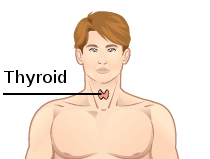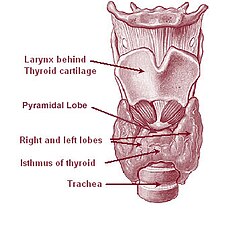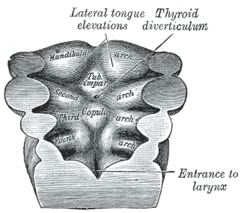Thyroid
The thyroid is one of the largest endocrine glands in the body. This gland is found in the throat. The thyroid controls how quickly the body burns energy, makes proteins, and how sensitive the body should be to other hormones.
The principal hormones it makes are thyroxine (T4) an triiodothyronine (T3), which is more active. These hormones regulate the growth of many systems in the body. T3 and T4 are synthesised from iodine and tyrosine. The thyroid also makes calcitonin, which plays a role in calcium homeostasis.
Diseases
Hyper- and hypofunction (affects about 2% of the population)
- Hypothyroidism (underactivity) - Hypothyroidism is a condition in which the thyroid gland does not make enough thyroid hormone.
- Hashimoto's thyroiditis / thyroiditis
- Ord's thyroiditis
- Postoperative hypothyroidism
- Postpartum thyroiditis
- Silent thyroiditis
- Acute thyroiditis
- Iatrogenic hypothyroidism
- Hyperthyroidism (overactivity)
- Thyroid storm
- Graves-Basedow disease
- Toxic thyroid nodule
- Toxic nodular struma (Plummer's disease)
- Hashitoxicosis
- Iatrogenic hyperthyroidism
- De Quervain thyroiditis (inflammation starting as hyperthyroidism, can end as hypothyroidism)
Anatomical problems
- Goitre
- Lingual thyroid
- Thyroglossal duct cyst
Tumors
- Thyroid adenoma
- Thyroid cancer
- Papillary
- Follicular
- Medullary
- Anaplastic
- Lymphomas and metastasis from elsewhere (rare)
Deficiencies
Additional images
Thyroid Media
The thyroid gland surrounds the cricoid and tracheal cartilages and consists of two lobes. This image shows a variant thyroid with a pyramidal lobe emerging from the middle of the thyroid.
The thyroid was named by Thomas Wharton after the ancient Greek shield of a similar pronunciation. Shown is an example of such a shield, as engraved on a coin dating from 431 to 424 BCE.
Related pages
Other websites
- American Thyroid Association (Thyroid Information and professional organization)
- New Management Guidelines for Patients with Thyroid Nodules and Differentiated Thyroid Cancer[dead link] from the American Thyroid Association Taskforce.
- Thyroid Disease Manager (free online textbook)
- Thyroid Disease (Nuclear Medicine Information)
- The Thyroid Foundation of America (Education about Thyroid Disease)
| Endocrine system |
| Adrenal gland - Corpus luteum - Hypothalamus - Ovaries - Pancreas - Parathyroid gland - Pineal gland - Pituitary gland - Testes - Thyroid gland - Hormone |









